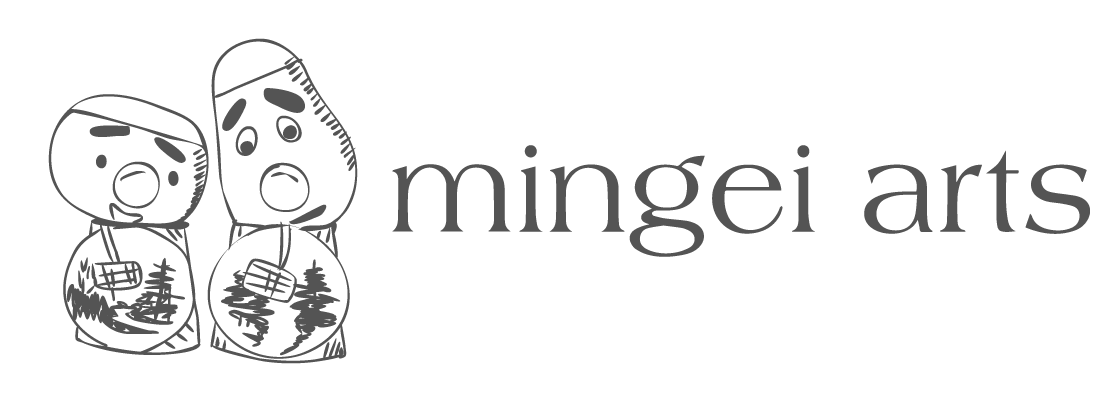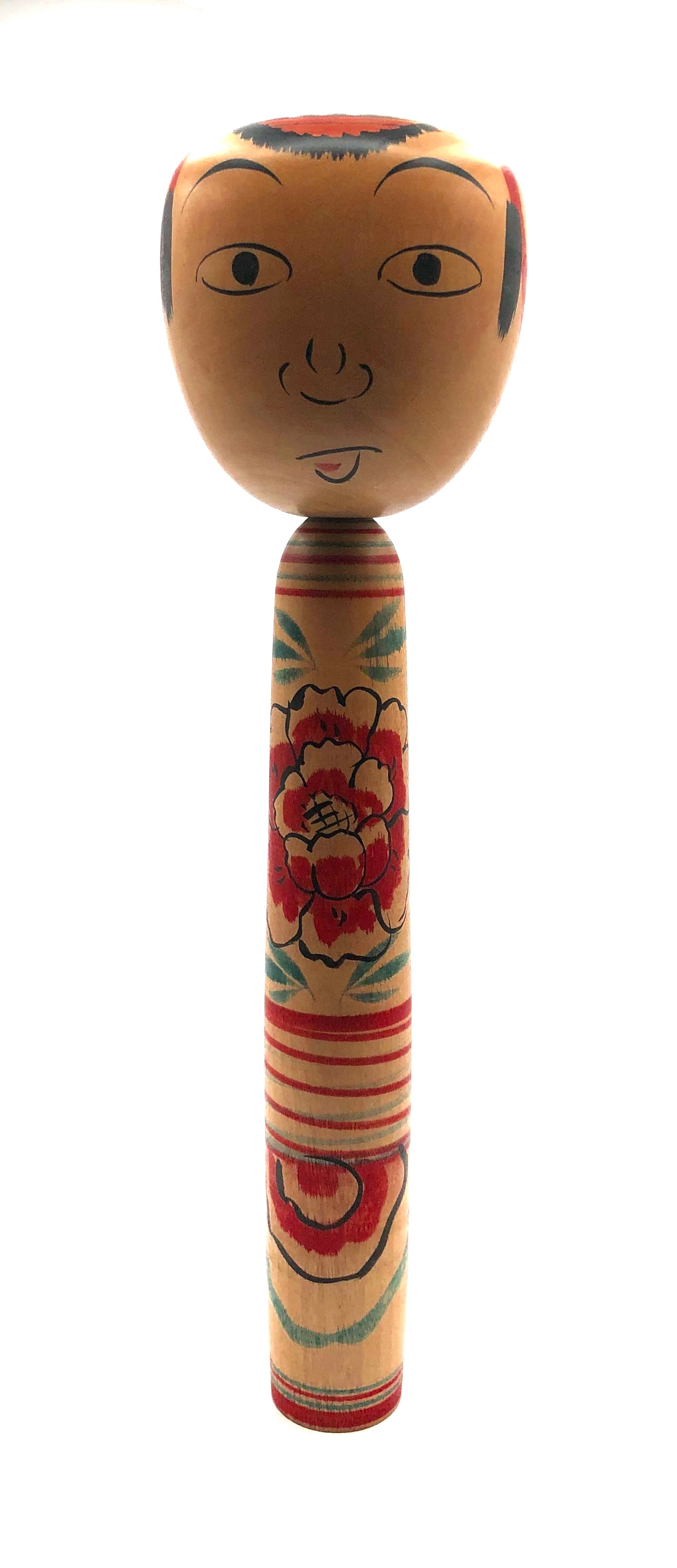
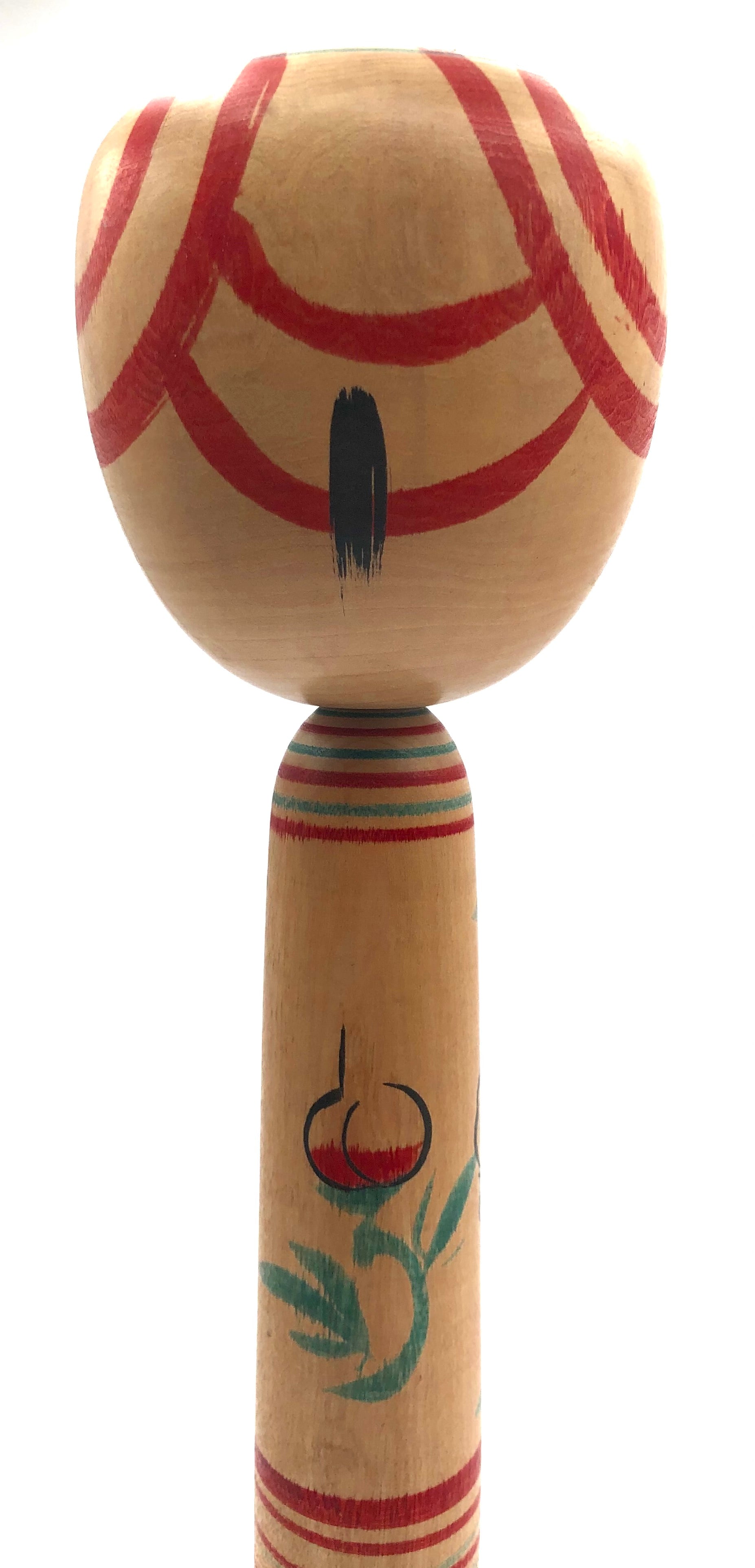
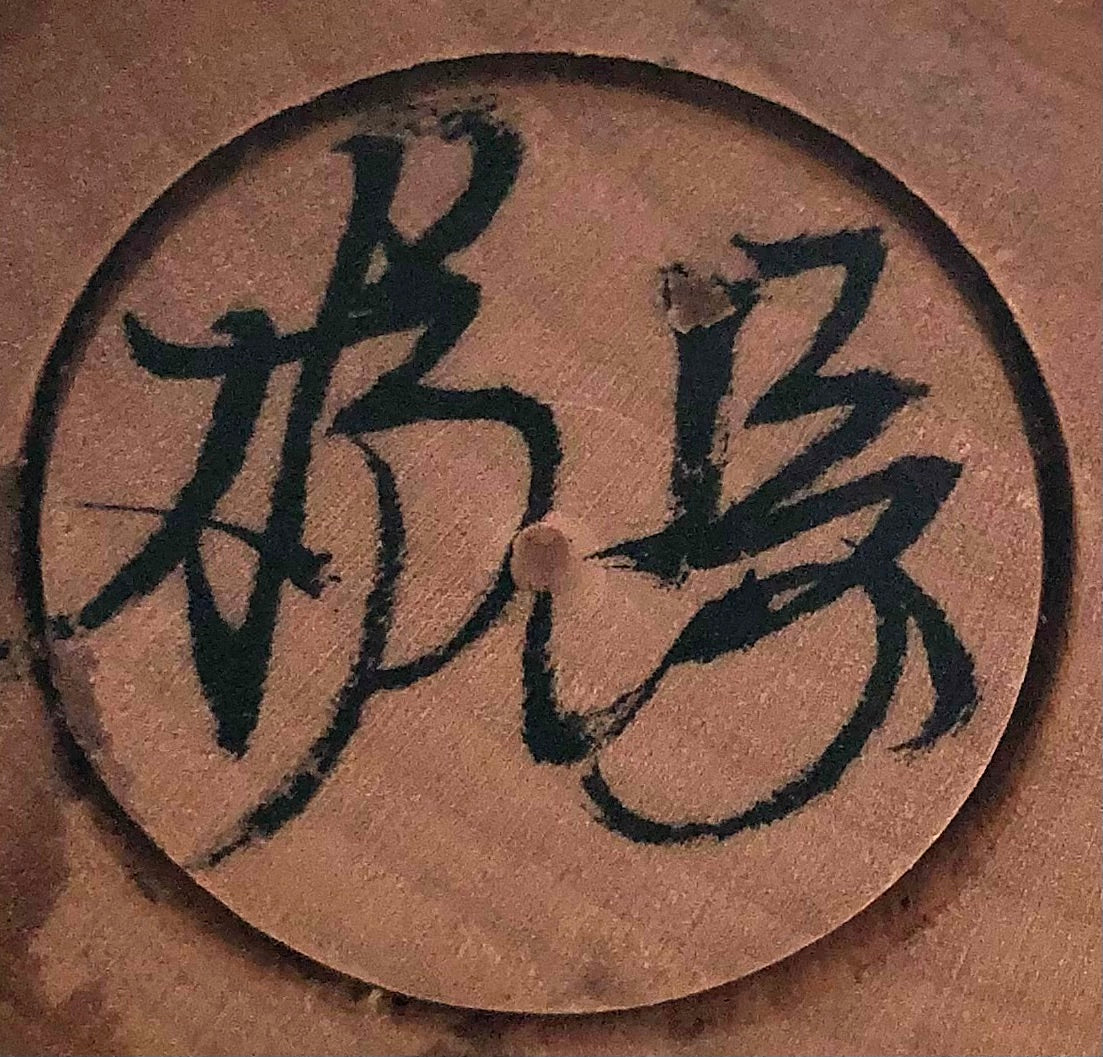
Vintage Japanese Traditional Nakanosawa Kokeshi “Takobozu” by Fumio, Kakizaki (1947-)
Dimensions: 12-0”h
This is a traditional Nakanosawa Kokeshi and is unusual because of its size. It is by one of the family's Grand carvers. He apprenticed under Takeo, Takahashi, and Yoshizo, Iwamoto, one of the original craftsmen who helped establish this style in the 1920s. This family of dolls was previously considered a sub-strain of the Tsuchiyu style.
The specific type of Kokeshi is often described as male rather than female, by Kokeshi enthusiasts even though it was not specifically designed to be a male. It is referred to as "Tako bozu", (bald boys), with an octopus face and shaven head reminiscent of the hairstyle worn by monks. The facial expression shows humor that is representative of Iwamoto Kenichi, a street dancer, (Sutorītodansā), in the 1920s, who used a cushion that had a face with large eyes painted on it. His audience was soon so taken with his dance with the pillow that they asked for a doll to be made with these special features.
This Kokeshi has a characteristically over-sized head, with a long tuft of hair on the head, cascading down the back. This is based on what was known as the YORISIRO phenomenon, and it is a very important Shinto concept for Buddhists and has long had a social, religious, erotic, and psychological significance. The doll additionally has side hair fringes which was typical of practitioners of the Zen Buddhist faith. The doll shows large expressive Bikkuri-me, surprised eyes, and the expressive ’Shishi-bata’, a Lion’s nose with flared nostrils. He exhibits a faint reddish-to-pink blush around the eyes, and an open mouth with a red tongue, which were painted originally on the dancer's pillow. Seen are ‘Janome’ black rings painted on the top of its head with abstract peony petals on the side with bangs. ‘Rokoru moyo’, red bands are incorporated below the neck and lower body on the thin and tapering body. The painted body incorporates two large open red and black peony flowers inspired by the tattoos that the Geisha sported. The doll is signed by the artist on the bottom of the doll by Fumio-san.
See additional writings on our website related to this subject
Condition: Excellent, meaning that the piece retains its original craft/workmanship, showing a wonderful- developed patina commensurate with its vintage. It is void of damage, cracks, breakage, or repairs, and meets all the standards of the collectible Traditional Nakanosawa Kokeshi, recording the historical significance related to the establishment of this family of dolls and its uniqueness.
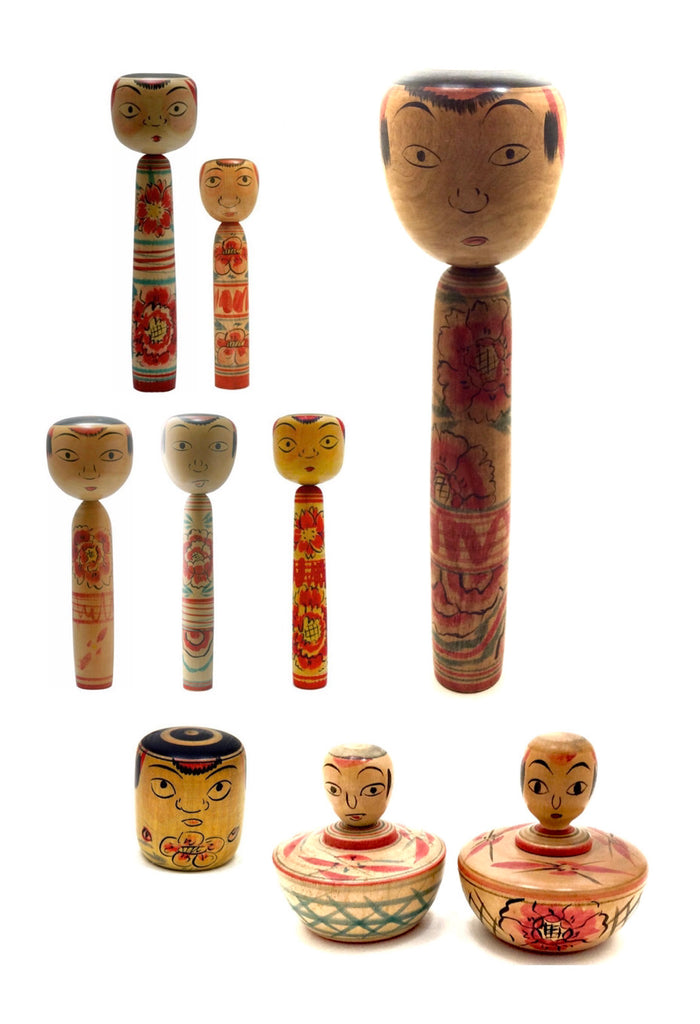
Japanese Traditional Kokeshi
Nakanosowa-Kei (Family)
Prefecture: Fukushima
Origin:
The Nakanosawa doll is a member of the Tsuchiyu family and one of the “youngest” of the twelve styles of Kokeshi. and recognized as a separate style in the mid-1920s, and so different from the rest of the Tsuchiyu family that it warrants its description and category. This distinctively painted traditional doll was created in Nakanosawa Onsen, in the town of Inawashiro, Fukushima Prefecture, by Iwamoto Zenkichi, one of the original founding members of the Tsuchiyu family. The facial expression shows humor that is representative of Iwamoto Kenichi, a street dancer (Sutorītodansā), in the 1920s, who performed a fast tempo foot dance called a "kappore fore”, Zenkichi-san then created a Kokeshi doll copied after a pillow that he used in this dance. The painted pillow had facial features as well as bold flower patterns. Additionally, Kenichi-san gave dancing lessons to local geisha girls, and his audience was soon so taken with his dance with the pillow that they asked for a doll to be made with these special features with the characteristically large popping eyes, and when the doll was originally made of papier maché.
Later, lathe-turned representations of dolls emerged as expressive wooden and painted forms. With Kenichi’s son, Yoshizou, and a group of craftsmen, the making of the Nakanosawa doll was alive and its popularity grew. While considered a sub-strain of the Tsuchiyu Kokeshi, these beguiling dolls have a special attraction to collectors because of their history. This specific type of Kokeshi is often described as male rather than female by Kokeshi enthusiasts, even though it was not specifically designed to be male. The doll later became known as "Tako bozu” (たこ坊主, bald boys), i.e., an octopus face with a shaven head, reminiscent of the hairstyle worn by monks.
Collector's note – characteristics / painting style:
The Nakanosowa doll was made like the rest of the traditional Kokeshi, with a large oval or rounded blocky head with reddish to pink blush on each cheek, on a thin, tapering body. The most characteristic element is the large, expressive, surprised-looking eyes (bikkuri-me). The dolls also have very different noses, with expressive Shishi-bata Lion’s nose and flared nostrils. Its mouth is fully open and accented in red. These dolls have bangs or side tufts and occasionally one long tuft of hair that has the purpose of being a perch for gods. This is based on what was known as the “Yorisiro” phenomenon, and it is a very important Shinto concept of “purity”, which was typical of practitioners of the Zen Buddhist faith. The body decoration of this strain typically consists of large open peonies inspired by the tattoos that the Geisha sported, or double cherry blossoms, incorporated with zig-zag (kaeshi rokuro) lines in multiple colors. The rarest form of this doll is an Ejiko-style called Izume.ko, Doll (“Isume baby”).

Leading Craftsmen:
Arakawa, Yoichi, 1936- No additional published information
Iwamoto, Zenkuchi, 1926, Grand Master- No additional published information
Iwamoto Yoshizo, 1912-1973, Grand Master- No additional published information
Kakizaki, Fumio, 1947- No additional published information
Fumio, Kakizaki, 1947, (Inawashiro, Fukushima) - Master: Iwamoto, Yoshizo. No additional published information
Honda, Nobuo - 1918-1995, Tsuchiyu Lineage. Master: Iwamoto Yoshizo. the eldest son of Honda Rugoro and Saki in Nakanosawa, Yama District, Fukushima Prefecture (2855 Numajiriyamako, Kanyo, Inawashiro Town). He apprenticed with Iwamoto Yoshizo and learned woodworking techniques. At the same time, he was exposed to toys and Kokeshi dolls which at the time were all made by a division of labor, and Iwamoto’s works were made with the help of Nobuo. In 1946 he moved to the mountain areas with Iwamoto Yoshizo to collect materials for kokeshi dolls and toys. From 1950 to 1955, he explored new types of kokeshi doll making and introduced his form of Ejiko dolls painted with whitewash in the 1970s. His hobbies were confectionery making and photography, and served as a photographer at various events in the introduction of and publication of the Nakanosawa doll. No additional published information
Sato, Tokuju, 1926-2021, (Aizu-waka-matsu) - Master: Iwamoto, Yoshizo. He was the second son of Shigeru Saito and in 1948, he found some relief and worked as a self-taught fashion designer. In 1955 he began making kokeshi dolls for souvenirs and in 1956, he was encouraged by Yoshiharu Inoue (father of Yukiko Inoue) of Aizu-Wakamatsu to move his studio Named “Roman Kokeshi Saito Kobo” to Aizu-Wakamatsu. In 1966, he began training in wood carving under Suzuki Chisato. In May 1968, he became an apprentice under Iwamoto Yoshizo of Nakanosawa. He received instruction in Takobozu Kokeshi from Yoshizo-san, and continued to make Kokeshi thereafter. In 1979, he won an Excellence Award at the Fukushima Prefecture Tourist Souvenir Competition. No additional published information.
Sabe Harou, 1929 -No additional published information
Seya, Kouji, 1952, (Nakanosawa) - Master: Iwamoto, Yoshio. No additional published information
Seya, Juji, 1924-2004, (Inawashiro, Fukushima) - Master: Iwamoto, Yoshizo. No additional published information
Takahashi, Yoshi, 1927, (Hino, Tokyo) - Master: Takahashi, Chuzo.No additional published information
Explore & Learn More about Nakanosowa-Kei (Family)